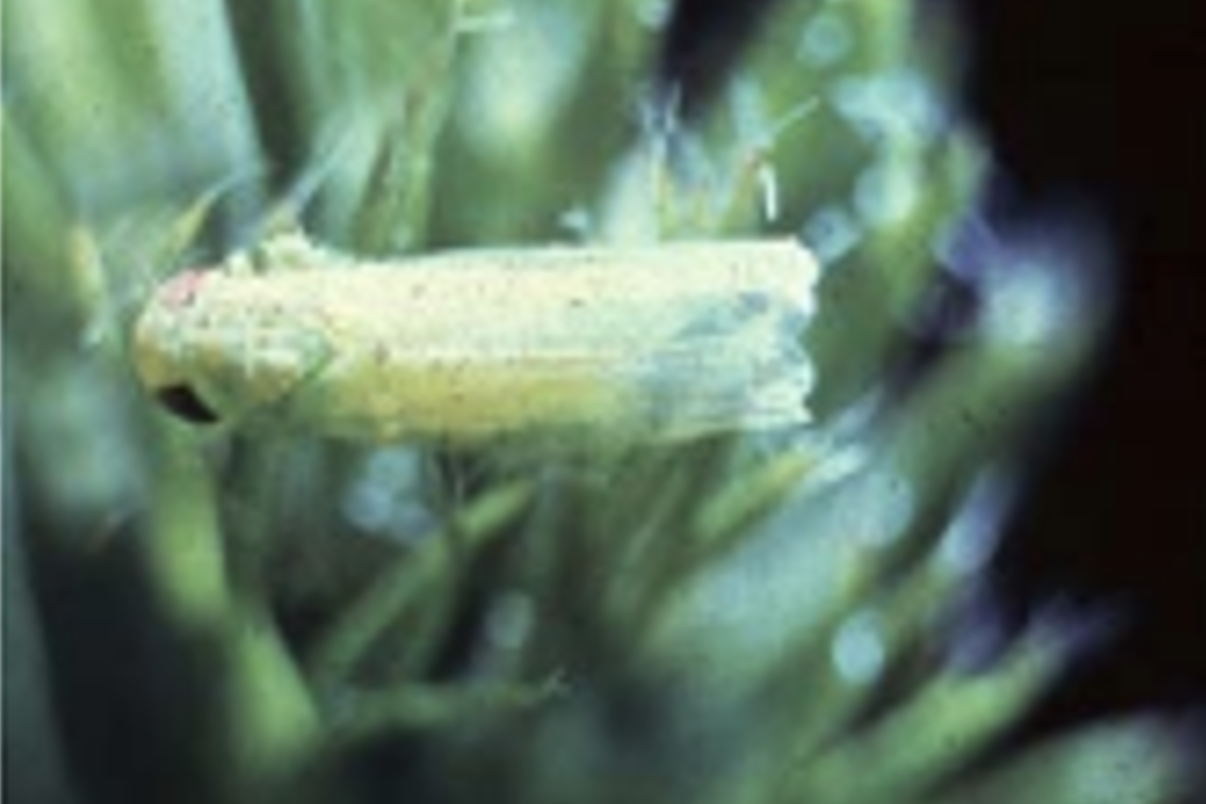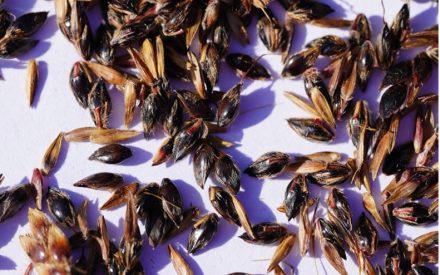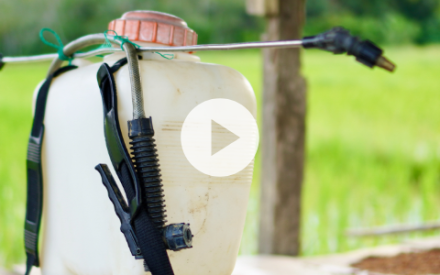Potato leafhopper (Empoasca fabae) is a serious economic pest across multiple cropping systems such as all types of beans, clover, apples, and potatoes. Alfalfa is a valuable forage crop widely cultivated for its high protein content and ability to fix nitrogen in the soil. Alfalfa production is highly susceptible to a range of insect pests, including the potato leafhopper. This small, green, wedge-shaped insect can cause substantial damage to alfalfa stands, reducing yields and diminishing forage quality with its feeding and pathogen vectoring capabilities. In this article, we will explore the key aspects of potato leafhopper management in alfalfa, providing practical recommendations to help farmers protect their crops and maximize productivity.
Photos: Potato leafhopper and leaf hopper nymph. UW-Madison Field Scouting Manual
Understanding the Potato Leafhopper
Potato leafhoppers are tiny, green ‘true bugs’ that feed by piercing the plant tissues with their mouthparts, extracting plant sap. They have a particular affinity for alfalfa and reproduce quickly, leading to population ‘booms’. In Wisconsin, potato leafhoppers start to arrive in April, but economically damaging populations are not usually present until the second or third cutting of Alfalfa (mid-June through August). The damage inflicted by potato leafhoppers may result in stunted growth, yellowing of leaves (hopper burn), and reduced forage quality. Early detection and management is critical to minimize the pest’s economic impact.
Potato Leaf Hopper and leaf hopper nymph. Credit: UW –Madison Field Crop Scouting Manual
Identification & Monitoring
Adult plant leaf hoppers are small (1/8-inch long), green & wedge-shaped. Their body is widest at the head, tapering down their bodies. All stages have piercing-sucking mouthparts, jump quickly when disturbed, or will fly if they are adults. The immatures (called nymphs) look like miniature versions of the adults, are pale green to yellow, and do not have wings.
Regular monitoring is essential to detect the presence of potato leafhoppers in alfalfa fields. To determine if there are potato leafhoppers in your field, take 20 consecutive sweeps at 5 different locations using a 15-inch diameter seep net. This will allow you to estimate if you have reached the economic threshold, see figure 1.
Damage Description
Unlike some other crop pests, potato leaf hopper adults and nymphs both damage the alfalfa plant by sucking the plant sap and injecting a toxic saliva that inhibits water and nutrient transport into the plant. Damage symptoms appear as yellowing of the leaves in a V-shaped pattern starting at the tip of the leaf. As a result of the plant yellowing, economic damage from leaf hoppers includes yield loss, quality loss, and reduction of plant vigor. Reduction of plant vigor can cause slower recovery of regrowth after cuttings, increased stand loss from winter kill, and potential yield loss for the following growing season if potato leaf hopper populations are high.
Integrated Pest Management (IPM) Strategies
Implementing an Integrated Pest Management approach is vital for sustainable and effective potato leafhopper control. IPM the combination of a range of tactics to suppress pest populations, often minimizing the need and use of pesticides. We propose integrating the following approach:
a. Cultural Practices:
Planting: If you have a year-after-year issue with potato leaf hoppers, consider planning resistant varieties.
Timely harvesting: Schedule the first cutting of alfalfa early in the season before potato leafhopper populations peak.
Proper fertility management: Maintain optimal soil fertility to promote healthy, vigorous alfalfa growth, as healthy plants are better equipped to withstand and recover from pest damage.
b. Biological Control:
Beneficial insects: Encourage natural enemies of potato leafhoppers, such as lady beetles, lacewings, and parasitic wasps, by providing habitat diversity and minimizing pesticide use.
Conservation biological control: Create hedgerows, wildflower strips, or insectary plants near alfalfa fields to support beneficial insect populations.
c. Chemical Control:
Threshold-based approach: Utilize the economic thresholds below to determine when to spray for potato leafhoppers. Only use insecticides when both the pest and crop are listed on the label.
Selective insecticides: If chemical control becomes necessary, choose insecticides that specifically target potato leafhoppers while minimizing harm to beneficial insects. Remember, spraying for one pest often negatively impacts the beneficial insects in your field, which take longer to rebound than the pest.
Managing potato leafhoppers in alfalfa requires a comprehensive approach that encompasses monitoring, cultural practices, biological control, and selective pesticide use. By adopting an Integrated Pest Management strategy, farmers can effectively protect their alfalfa crops, minimize yield losses, and maintain high-quality forage production. Regular scouting, early detection, and timely action are critical for successful management. Remember to seek guidance from local agricultural experts and extension educators for region-specific recommendations and support. Together, we can sustainably manage potato leafhopper populations and ensure the productivity and profitability of alfalfa farming.



 ▶ Combine Cleaning: A Simple Step to Reduce Weed Seed Dispersal
▶ Combine Cleaning: A Simple Step to Reduce Weed Seed Dispersal Johnsongrass in Wisconsin
Johnsongrass in Wisconsin ▶ Backpack Sprayers in Diversified Vegetable Systems
▶ Backpack Sprayers in Diversified Vegetable Systems ▶ AI in Agriculture
▶ AI in Agriculture


